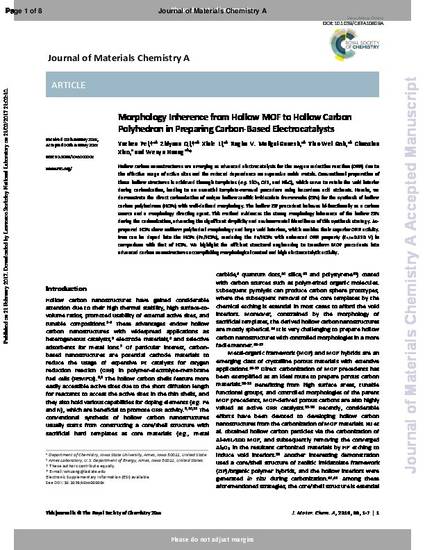
Hollow carbon nanostructures are emerging as advanced electrocatalysts for the oxygen reduction reaction (ORR) due to the effective usage of active sites and the reduced dependence on expensive noble metals. Conventional preparation of these hollow structures is achieved through templates (e.g. SiO2, CdS, and Ni3C), which serve to retain the void interiors during carbonization, leading to an essential template-removal procedure using hazardous chemical etchants. Herein, we demonstrate the direct carbonization of unique hollow zeolitic imidazolate frameworks (ZIFs) for the synthesis of hollow carbon polyhedrons (HCPs) with well-defined morphologies. The hollow ZIF particles behave bi-functionally as a carbon source and a morphology directing agent. This method evidences the strong morphology inherence from the hollow ZIFs during the carbonization, advancing the significant simplicity and environmental friendliness of this synthesis strategy. The as-prepared HCPs show a uniform polyhedral morphology and large void interiors, which enable their superior ORR activity. Iron can be doped into the HCPs (Fe/HCPs), providing the Fe/HCPs with enhanced ORR properties (E1/2 = 0.850 V) in comparison with those of HCPs. We highlight the efficient structural engineering to transform ZIFs into advanced carbon nanostructures accomplishing morphological control and high electrocatalytic activity.
Available at: http://works.bepress.com/wenyu_huang/51/

This is a manuscript of an article published as Pei, Yuchen, Zhiyuan Qi, Xinle Li, Raghu V. Maligal-Ganesh, Tian Wei Goh, Chaoxian Xiao, Tianyu Wang, and Wenyu Huang. "Morphology inherence from hollow MOFs to hollow carbon polyhedrons in preparing carbon-based electrocatalysts." Journal of Materials Chemistry A 5, no. 13 (2017): 6186-6192. DOI: 10.1039/C6TA10609A. Posted with permission.